Wearable technology has revolutionized many aspects of daily life. Its impact on healthcare and telemedicine stands out as particularly transformative. From fitness trackers to smartwatches and medical-grade devices wearables have seamlessly integrated into patient care. They allow for continuous monitoring. Enable remote diagnostics This intersection of technology and healthcare represents paradigm shift. Offering both patients and healthcare providers new tools is essential to improve outcomes reduce costs and enhance overall quality of life.
Enhanced Monitoring and Real-Time Data
One of most significant contributions of wearables to modern healthcare is their ability to provide real-time health monitoring. Traditional healthcare models often rely on episodic visits to healthcare providers. This approach can miss crucial changes in patient's health status between appointments. Wearables bridge this gap by continuously collecting and transmitting data on vital signs. They also track activity levels sleep patterns and more. For example fitness trackers can monitor heart rate. They can also monitor physical activity. Smart clothing can track posture. It can also track movement.
This continuous stream of data enables healthcare providers to monitor patients remotely. It also helps detect early signs of health problems. For patients with chronic conditions such as diabetes or hypertension wearables offer proactive approach to managing their health. They allow for timely interventions. They allow adjustments to treatment plans based on real-time insights.
Remote Patient Monitoring and Telemedicine
Remote patient monitoring (RPM) has emerged as a cornerstone of modern telemedicine, facilitated by wearable technology. RPM allows healthcare providers to monitor patients' health outside of traditional clinical settings, reducing the need for frequent in-person visits and improving access to care, especially in rural or underserved areas. Wearable devices equipped with sensors can transmit data securely to healthcare providers, who can then analyze trends, assess adherence to treatment protocols, and intervene as needed.
Telemedicine platforms integrate wearable data with video consultations, enabling healthcare providers to conduct virtual visits and make informed decisions about patient care. This approach not only enhances convenience for patients but also reduces healthcare costs associated with hospital admissions and emergency room visits. Moreover, telemedicine has proven invaluable during public health emergencies, allowing healthcare systems to maintain continuity of care while minimizing exposure risks for patients and providers alike.
Personalized Medicine and Treatment
Wearable technology plays a crucial role in advancing personalized medicine, tailoring treatment plans to individual patient needs and characteristics. By continuously monitoring physiological data, wearables provide a comprehensive view of a patient's health over time, enabling healthcare providers to make data-driven decisions about diagnosis, medication adjustments, and lifestyle interventions. For example, wearable ECG monitors can detect abnormal heart rhythms, prompting timely interventions to prevent cardiovascular events.
The integration of artificial intelligence (AI) and machine learning further enhances the utility of wearable data in personalized medicine. AI algorithms can analyze vast amounts of wearable data to identify patterns, predict health outcomes, and recommend personalized interventions. This data-driven approach not only improves patient outcomes but also enhances efficiency in healthcare delivery by prioritizing resources and interventions based on individual risk profiles.
Empowering Patients and Promoting Wellness
Beyond clinical applications, wearables empower patients to take an active role in managing their health and wellness. By providing real-time feedback on fitness goals, sleep quality, and stress levels, wearables encourage healthy behaviors and lifestyle modifications. For instance, fitness trackers can motivate users to increase physical activity by setting personalized goals and providing feedback on progress.
Wearables also facilitate patient engagement and education through interactive apps and user-friendly interfaces. Patients can access educational resources, track their health metrics, and communicate securely with healthcare providers through integrated platforms. This transparency and accessibility foster a collaborative approach to healthcare, where patients and providers work together to achieve optimal health outcomes.
Challenges and Considerations
Despite their potential benefits, wearables present several challenges and considerations for healthcare stakeholders. Privacy and data security are paramount concerns, as wearable devices collect sensitive health information that must be protected against unauthorized access and breaches. Regulatory frameworks, such as the Health Insurance Portability and Accountability Act (HIPAA) in the United States, impose strict guidelines on the storage, transmission, and use of health data to ensure patient confidentiality and compliance.
Moreover, the accuracy and reliability of wearable data can vary depending on device design, sensor technology, and user compliance. Healthcare providers must carefully evaluate the clinical validity of wearable data and integrate it with traditional diagnostic methods to make informed clinical decisions. Standardization of data formats and interoperability between wearable devices and electronic health record (EHR) systems remain ongoing challenges that require collaboration across industry stakeholders and regulatory bodies.
Future Directions and Innovations
Looking ahead, wearable technology is poised to continue evolving and expanding its impact on healthcare and telemedicine. Advances in sensor technology, miniaturization, and battery life will enable the development of more sophisticated wearables capable of monitoring a wider range of health parameters with greater accuracy and precision. Wearables may also integrate additional functionalities, such as environmental sensors, biometric authentication, and AI-powered diagnostics, to further enhance their utility in healthcare settings.
Furthermore, the integration of wearables with emerging technologies like augmented reality (AR) and virtual reality (VR) holds promise for enhancing remote diagnostics, surgical training, and patient education. These immersive technologies can simulate clinical scenarios, provide real-time guidance to healthcare providers, and improve patient engagement through interactive visualizations and virtual consultations.
